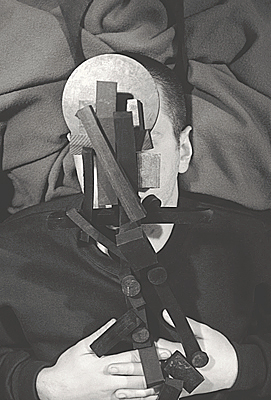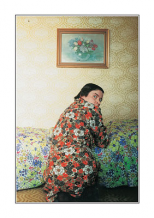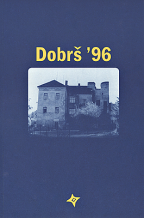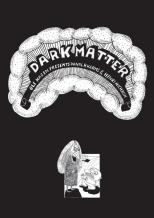| Umělec magazine 2001/5-6 >> Mesmerized Universal harmony in the individual world | List of all editions. | ||||||||||||
|
|||||||||||||
Mesmerized Universal harmony in the individual worldUmělec magazine 2001/5-601.05.2001 Marisa Příhodová a Lenore Malen | focus | en cs |
|||||||||||||
|
"Case Study
He has been hailed as the great-grandfather of parapsychology, the discoverer of hypnosis, the progenitor of clairvoyance, telepathy and communication with the beyond. And he has also been denounced as a rogue, a charlatan, and as selling his soul to the devil. Anyway you view him, Franz Anton Mesmer is remembered as being more than just a cultish magician. Born in 1734, he first gained fame in Vienna by purportedly curing seventeen-year-old “hysterically” blind pianist Maria Theresa Paradis (with whom it’s said he did more with than just cure). With the support of his wealthy wife and Viennese aristocrats, including the Mozart family (W. A. Mozart even employed one of Mesmer’s magnetic healing techniques in his opera Cosi Fan Tutte), he developed his own wild system of medical healing which he termed “animal magnetism.” He based the system closely on astrology, referring to the arrangement of planetary bodies and their gravitational forces upon humans. Beginning in Vienna he applied magnets to the bodies of his patients but soon felt that he could dispense with the magnets. Mesmer came to believe that he himself was an “animal magnet,” capable of “magnetizing” all who chose to cross his path and that a magnetic force emanated from his hands, enabling him to direct the actions and thoughts of his subjects. He believed that he could make this magnetic fluid flow from himself directly into the patient, relieving the vital forces that had become restrained or blocked within the body. Mesmer felt that it was this stoppage of the flow of magnetic fluid that caused illness. Some have simply snubbed his healing techniques as being a form of hypnotism, but others have seen in his work the beginning of psychotherapy, and Mesmer himself is often referred to as “the father of the mental health industry.” The word “mesmerize” — first recorded in the English language in 1829 — is a direct derivation from Mesmer’s name, not an honor bestowed upon many. But the discovery of the actual hypnotic state was in fact stumbled on by one of Mesmer’s disciples, the Marquis de Puysgur, as Mesmer was trying to heal a young shepherd boy. Rubbing the young boy’s head had put him into a hypnotic or spasmodic sleep. Through this experience the Marquis later went on to develope on the theory of the hypnotic state in his own work. Sigmund Freud made references to Mesmer’s animal magnetism and certainly believed in the power of what was later termed hypnotism. Parisian nobility, including Queen Marie Antoinette, fell hard for Mesmer, and General Lafayette, one of his greatest supporters, even used some of his treatments for seasickness. In one stunning example, he went so far as to strap himself to the mast of a ship in the belief that it was a magnetized tree, as Mesmer had asserted that even some inanimate objects could be used to pass on the magnetic fluid. Writers Poe, Emerson, and Hawthorne all make mention of Mesmer and from l800 to l850 Americans became exposed to a wide assortment of religious sects and utopian social movements, including those run by “Mesmerists.” These are a few of Mesmer’s original treatments: Magnets applied “First of all, one must place oneself opposite the patient, back to the north, bringing one’s feet against the invalid’s; and run fingers all over the patient’s body seeking the poles of the small magnets that compose the great magnet of the body as a whole.” “If it is a disorder of the eyes, one lays the left hand on the right temple. One then opens the eyes of the patient and brings one’s thumbs very close to them. Then the thumbs are run from the root of the nose (the bridge) all around the socket.” “It is always necessary that one hand is on one side, and the other hand is on the opposite side. If the sickness is general, the hands — made into a pyramid with the fingers — are passed over the whole body, starting at the head and then descending along the two shoulders down to the feet.” “The best method of establishing rapport with a patient is to rely on the stable magnets such as those of the fingers and the nose and to avoid areas like the North POLE at the top of the head, which usually receives mesmeric fluid from the stars and the South POLE in the feet, which are natural receptors of terrestrial magnetism.” Diagnosis Examination of Mesmer’s treatments calls to mind New Age fundamentals like acupressure, Chakras, or even sensual massage. At the time it came across as being highly scientific, with references to astrology and science thrown in for added credibility and assurance. Yet there are documented cases that his sexual-style healing did indeed “cure” some patients, or at least they felt a whole lot better afterwards. Mesmer seemed to realize the effects that sexual repression had on people, and the numerous nervous conditions and disorders which stemmed from this. His seductive remedies released many neurotic patients from the bondage of mental and sexual insecurity, something contemporary society still encourages. It’s said that he even urged his female patients to wear loose robes or garments during treatment so he could better relieve the flow of fluid from particular areas of the body (including the breasts, buttocks, and even, in some cases, the genitals). His treatments became so widely known and the number of patients seeking him out so large that Mesmer had to invent a kind of “group therapy,” termed baquet, in order to deal with them all. It is believed that the baquet was a large wooden tub from which long metal rods protruded. All participants, seated on chairs, were obliged to grasp the rods in mutual harmony. He received large fees for servicing wealthy aristocrats, but it’s also on record that Mesmer treated hundreds of peasants for free. Mesmer likened the movement of fluid within the body to the tides of the sea. Through a careful selection of words and with the right voice inflection, combined with the sensitive passing of his hands over the body, Mesmer was able to induce a “crisis” — or convulsions — with patients foaming at the mouth or falling into a trance that would often result in loss of consciousness. Fortunately he worked in rooms padded with mattresses (similar to contemporary asylum isolation rooms), which he called “crisis rooms” to accommodate these trances. While it may be claimed that Mesmer’s far-fetched healing practices induced nothing more than placebo effects, unorthodox doctors, Holy Ghost bartenders, churches, communes and even people referring to themselves as revival Mesmerists have recently begun to regenerate similar results using his techniques! Toward the end of his career Mesmer formed the belief that patients could help themselves (of course once versed in his healing ways). Groups and organizations, books, tapes and videos promoting self-help (an ironic contemporary term in itself, since it requires initial help from an outside source) now dominate the world of psychotherapy and Western society in general. And group therapy institutes such as The Forum (formerly EST) and Lifespring have become multi-million dollar industries with the one alleged aim of resolving human mental dilemmas. He also invested faith in telepathy, clairvoyance and prevision, all of which are still summoned daily by countless psychic telephone hotlines, television and radio programs, and hypnoerotic websites. Yet from within this confused and ever-spreading nation of therapists and depression-drug dealers there emerges one point of clarity: There is still much left to be explored on the enormous power of suggestion and the subtle human touch. Healing Mesmer has also been revived in the world of Contemporary Fine Art in The New Society for Universal Harmony, a project by New York-based artist Lenore Malen. Comprised of a photographic and audio installation, book and video, it is a virtual re-creation of the original Societe de l’Harmonie Universelle, which was founded in France in 1783 by Nicholas Bergasse to propagate the theories of F.A. Mesmer. Presenting photos and stories taken from a completely invented reality, the work explores non-medical, extraordinary, psychic healing therapies by drawing upon speculative aspects of Enlightenment science and medicine. Malen’s New Society for Universal Harmony expresses our own culture’s yearnings for a panacea. Except that what the patients undergo is darkly funny and improbable, suggesting that there is no cure for what ails the souls of these fictional patients. Mesmerism lies somewhere between a desperately confident, optimistic view of science’s ability to cure anything and a mystical, occult diversion. In this way, it corresponds perfectly to the interests of the literate French of the 1780s. The pseudo-documentary photos updating Mesmer’s own treatments are wildly humorous yet emit an obscure despair. The “patients” in Malen’s institute undergo therapy by performing strange acts such as ritual baptisms and dances, or tying themselves with electric cords and attaching magnets to their bodies. Malen’s photos were inspired by existing documentary images from the Kinsey Institute Archives, as well as by stills depicting madness from productions of Peter Weiss’ Marat/Sade and by the 1862 photographs of the French anatomist G. B. Duchenne de Bologne. The book Malen has created consists of fictionalized short stories, written by both Malen and the “patients,” about their past and present traumas, including the appropriate cures proposed by the resurrected “Mesmer” and his practitioners at the institute. Malen’s work draws parallels between Mesmer’s far-flung mental universe and the Western world. The New Society is at once playful and ironic, questioning Western society’s desperate desire for novel mental cures and treatments, as the hunt for escapist fictional worlds goes on. The New Society for Universal Harmony Case I: The Tornado Ms. G. sought out treatment because of her inability to make decisions. She was ambivalent, obsessive, unable to comprehend the possibilities laid out for her and her future. Throughout the interview she talked about herself as if she were a character in a story, suggesting severe depersonalization. She began: This story is called The Tornado: She came from a town in Florida that was devastated by a tornado. Like all tornadoes, the storm took a narrow path veering this way and that way, destroying her house, but leaving the houses on either side intact. Her neighbors were fine, their houses were standing. Her family, though, had died in their bedrooms while she was out shopping for peaches. She grieved and grieved. Her friends surrounded her and loved her. She moved to a different town in a vain effort to suppress painful memories. On a walk one day she came upon a dog about six years of age, injured on the road. Judging from his glazed eyes, shallow breathing, lolling tongue, he was mortally wounded. Nevertheless, she called for help, rescued him and paid for his treatments. He had many fractures and internal injuries and she nursed him for nearly two years. In constant pain, the dog never seemed grateful, but she knew he was. Right before he died he said: Tell me three wishes. I will grant them to you. And she said: Sex first, then Love and Death. Several years later she met Sex. He was a nice-looking foreign man. He played the bass. He played with his fingers and thumbs, and the base of his thumb, he strummed and plucked the bass and they made music in the key of D. She played him like an oboe, his instrument in high school, in the key of E. Their music was high, the two instruments coming together and then apart. The next time Sex visited her was in the form of a goat, who faced her while rearing up on his hind legs. His small, white, fur-covered pate was a blur of constant motion. Coarse white hairs sprouted from his plump belly and balls. His appetite was keen and they played on and on, always together. Their music was symphonic, lasting through many movements. But now it was over. She agonized. Had the time come for the next wish? She didn’t know and hence she came to the New Society. And what would that wish be: Love or Death, Love or Death? — We recommended magnetic somnambulism, work on the larger machines and group couching in the atrium. She would see Mesmer once a week. At the end of her stay, no longer ambivalent, she had come to a realization. The answer to her question was: WHATEVER COMES FIRST. Recovery After wandering for several years, Mesmer settled back down near his place of birth. There he led a reclusive life, practising a little medicine and playing his glass harmonica (which he had used earlier in his practice for the purpose of creating additional healing vibrations for his patients). His last wish before his death in 1815 was that a priest play his glass harmonica by his side. Despite eventually returning to the Catholic Church, from which he had strayed, he still remained, in a sense, “Mesmerized” by his views on animal magnetism. Another particular belief Mesmer held resolute to the end was the importance of people maintaining a close interest and sympathy for one another, especially between physician and patient. In short, a rapport, which is French for “harmony” or “connection.” In the end Mesmer died in relative poverty and obscurity. References: – From Mesmer to Freud by A. Crabtree, Yale University, (1993) – Neurypnology by J. Braid, J. Churchill, London(1853) – The Counterfeit Revival by H. Hanegraaff, Word Publishing (1997) – Mesmerism, A Translation of the Original Scientific and Medical Writings of F.A. Mesmer, translated by G. Bloch (1980) – The Theosophical Enlightenment, J. Godwin, Albany (1994) – www.ladymesmer.com "
01.05.2001
Recommended articles
|
|||||||||||||
|
04.02.2020 10:17
Letošní 50. ročník Art Basel přilákal celkem 93 000 návštěvníků a sběratelů z 80 zemí světa. 290 prémiových galerií představilo umělecká díla od počátku 20. století až po současnost. Hlavní sektor přehlídky, tradičně v prvním patře výstavního prostoru, představil 232 předních galerií z celého světa nabízející umění nejvyšší kvality. Veletrh ukázal vzestupný trend prodeje prostřednictvím galerií jak soukromým sbírkám, tak i institucím. Kromě hlavního veletrhu stály za návštěvu i ty přidružené: Volta, Liste a Photo Basel, k tomu doprovodné programy a výstavy v místních institucích, které kvalitou daleko přesahují hranice města tj. Kunsthalle Basel, Kunstmuseum, Tinguely muzeum nebo Fondation Beyeler.
|



































 We Are Rising National Gallery For You! Go to Kyjov by Krásná Lípa no.37.
We Are Rising National Gallery For You! Go to Kyjov by Krásná Lípa no.37.
Comments
There are currently no comments.Add new comment